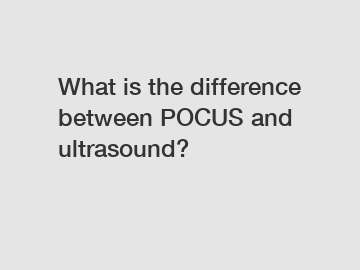Jan. 05, 2024
Health & Medical
What is the difference between POCUS and ultrasound?
POCUS, which stands for Point-of-Care Ultrasound, has become an increasingly popular tool in the medical field. However, many people wonder how it differs from conventional ultrasound. In this article, we will explore the key differences between POCUS and ultrasound, and discuss their respective applications, benefits, and limitations.
1. Definition and Purpose:

Point-of-Care Ultrasound (POCUS) is a specific application of ultrasound that allows healthcare professionals to perform real-time diagnostic imaging at the bedside. POCUS is primarily used to guide clinical decisions and aid in immediate patient care. On the other hand, conventional ultrasound refers to a broader field of medical imaging that utilizes high-frequency sound waves to produce images of the body's internal structures.
2. Scope and Focus:
Unlike conventional ultrasound, which requires formal training and expertise, POCUS is designed to be used by physicians and healthcare providers directly involved in patient care. POCUS devices are portable and handheld, making them ideal for use in emergency departments, intensive care units, and other clinical settings where immediate access to diagnostic information is crucial.
3. Versatility and Applications:
While conventional ultrasound covers a wide range of medical specialties and applications, POCUS is typically focused on a limited set of clinical scenarios. POCUS is commonly used to assess cardiac function, detect fluid accumulation, evaluate lung conditions, guide procedures such as central line placement, and aid in the diagnosis of various abdominal and musculoskeletal conditions.
4. Training and Expertise:
As mentioned earlier, POCUS can be used by non-radiologists with appropriate training. To effectively use POCUS, healthcare providers undergo specific training programs and certifications, typically offered by medical societies and educational institutions. Understanding the limitations and nuances of this imaging technique is crucial to ensure accurate and proper utilization of POCUS devices.
5. Access to Information:
One of the key advantages of POCUS is its ability to provide immediate, real-time information at the patient's bedside. This can expedite the clinical decision-making process and potentially reduce the need for additional diagnostic tests or interventions. Conversely, conventional ultrasound may require patients to be moved to a dedicated imaging facility, leading to delays in obtaining results and subsequently affecting patient care.
6. Limitations and Considerations:
While POCUS is a valuable tool in many clinical scenarios, it does have limitations. The handheld nature of POCUS devices may result in a smaller field of view compared to conventional ultrasound machines, which can limit the extent of anatomical assessment. Additionally, POCUS examinations may not always provide the same level of detail as traditional ultrasound studies, especially when conducting comprehensive assessments of certain regions or conducting complex diagnostic evaluations.
7. Complementary Roles:
Ultimately, POCUS and conventional ultrasound play complementary roles in the medical field. While POCUS provides immediate access to critical information, conventional ultrasound offers more comprehensive and detailed examinations, often involving specialized probes and more advanced imaging techniques. These complementary approaches allow healthcare providers to make informed decisions based on the specific clinical scenario and level of detail required.
In conclusion, Point-of-Care Ultrasound (POCUS) and conventional ultrasound are related but distinct tools utilized in the medical field. POCUS, specifically designed for bedside use by healthcare providers, enables real-time diagnostic imaging and immediate decision-making. While POCUS has its limitations regarding field of view and comprehensiveness, it greatly improves access to crucial information. Conventional ultrasound, on the other hand, offers more comprehensive assessments and is typically performed in specialized facilities. Both techniques have their respective roles and benefits, ultimately enhancing patient care and diagnostic capabilities. Understanding the differences between POCUS and conventional ultrasound is essential for healthcare professionals seeking to leverage the advantages of these valuable imaging tools.
For more cattle ultrasound equipment, ultrasound systems for sale, ultrasound productsinformation, please contact us. We will provide professional answers.
Previous: What are the top tips for purchasing Jiayi Ivermectin?
Next: Which is the most cost-effective supplier for chemical compound 55268-74-1?
If you are interested in sending in a Guest Blogger Submission,welcome to write for us!
All Comments ( 0 )